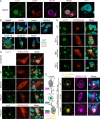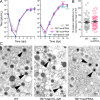Human cytomegalovirus deploys molecular mimicry to recruit VPS4A to sites of virus assembly
- PMID: 38900818
- PMCID: PMC11218997
- DOI: 10.1371/journal.ppat.1012300
Human cytomegalovirus deploys molecular mimicry to recruit VPS4A to sites of virus assembly
Abstract
The AAA-type ATPase VPS4 is recruited by proteins of the endosomal sorting complex required for transport III (ESCRT-III) to catalyse membrane constriction and membrane fission. VPS4A accumulates at the cytoplasmic viral assembly complex (cVAC) of cells infected with human cytomegalovirus (HCMV), the site where nascent virus particles obtain their membrane envelope. Here we show that VPS4A is recruited to the cVAC via interaction with pUL71. Sequence analysis, deep-learning structure prediction, molecular dynamics and mutagenic analysis identify a short peptide motif in the C-terminal region of pUL71 that is necessary and sufficient for the interaction with VPS4A. This motif is predicted to bind the same groove of the N-terminal VPS4A Microtubule-Interacting and Trafficking (MIT) domain as the Type 2 MIT-Interacting Motif (MIM2) of cellular ESCRT-III components, and this viral MIM2-like motif (vMIM2) is conserved across β-herpesvirus pUL71 homologues. However, recruitment of VPS4A by pUL71 is dispensable for HCMV morphogenesis or replication and the function of the conserved vMIM2 during infection remains enigmatic. VPS4-recruitment via a vMIM2 represents a previously unknown mechanism of molecular mimicry in viruses, extending previous observations that herpesviruses encode proteins with structural and functional homology to cellular ESCRT-III components.
Copyright: © 2024 Butt et al. This is an open access article distributed under the terms of the Creative Commons Attribution License, which permits unrestricted use, distribution, and reproduction in any medium, provided the original author and source are credited.
Conflict of interest statement
The authors have declared that no competing interests exist.
Figures







References
MeSH terms
Substances
Grants and funding
LinkOut - more resources
Full Text Sources

